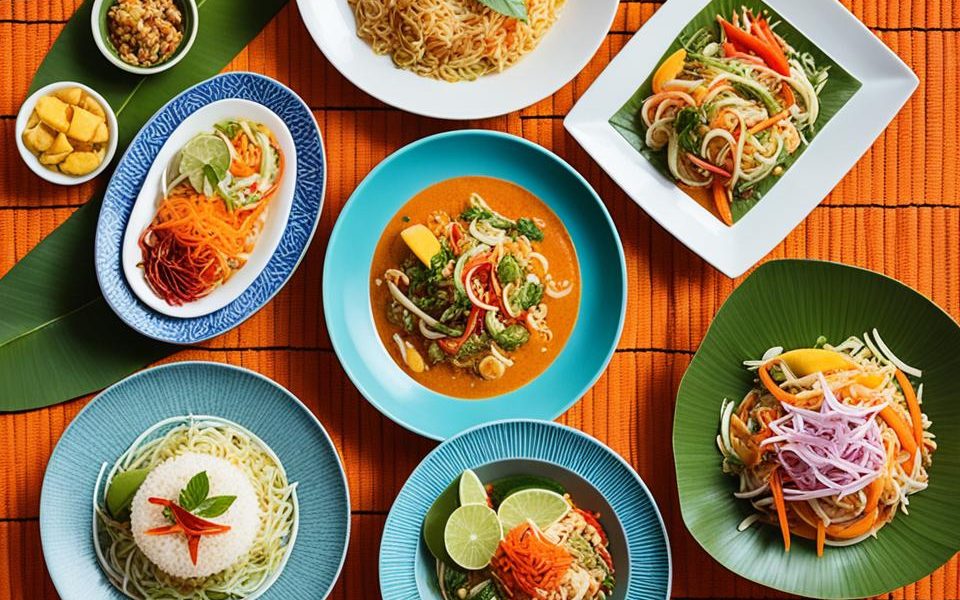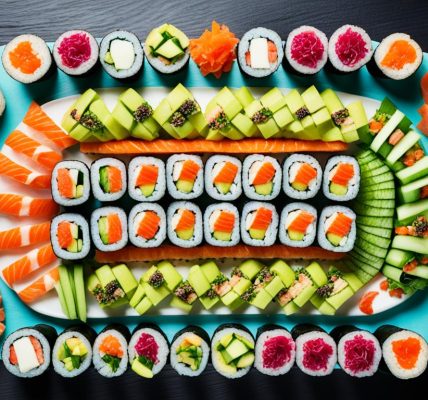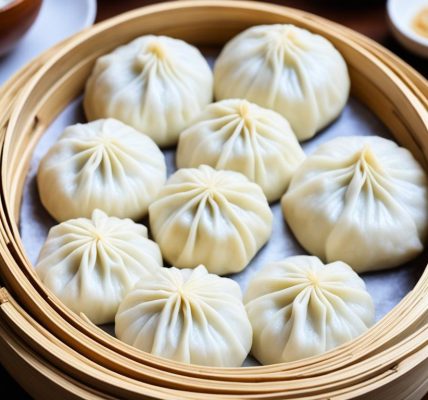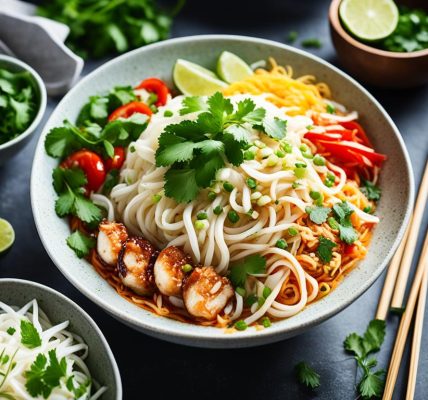Thailand is renowned for its vibrant and flavorful cuisine, which has captivated taste buds around the world. The question of what constitutes the country’s “national dish” has been a topic of much debate, as there are several iconic Thai dishes that could lay claim to this distinction. From the beloved pad thai to the fragrant tom yum goong soup, the diverse culinary traditions of Thailand offer a rich tapestry of flavors and ingredients that have become synonymous with the country’s culture and identity.
Read more interesting information at ::ds-collection
Introduction to Thai Cuisine
Thai cuisine is renowned for its bold and harmonious blend of flavors, combining sweet, sour, salty, and spicy elements to create dishes that are both complex and deeply satisfying. The culinary traditions of Thailand have been shaped by a rich history of cultural exchange and the abundance of local ingredients, resulting in a diverse and innovative cuisine that has captured the attention of food lovers worldwide.
Exploring the Vibrant Flavors of Thai Cooking
From the fragrant tom yum goong soup to the beloved pad thai, Thai dishes showcase a remarkable balance of flavors that is both intricate and captivating. The harmonious interplay of sweet, sour, and spicy notes, along with the generous use of fresh herbs and aromatic spices, defines the essence of Thai cuisine. This unique culinary approach has earned Thailand a well-deserved reputation as a gastronomic destination, with its national food and traditional Thai dishes becoming some of the most iconic Thai recipes enjoyed globally.
Thailand’s Diverse Culinary Influences
The rich tapestry of Thai cuisine has been woven together by a tapestry of cultural influences, from the ancient trading routes that connected the region to the influx of diverse immigrant communities over the centuries. The what is the national dish of thailand debate reflects the country’s culinary diversity, as various traditional Thai dishes and iconic Thai recipes have emerged as potential contenders for this coveted title.
What is the National Dish of Thailand?
Determining the definitive “national dish” of Thailand is a challenging task, as the country’s culinary landscape is incredibly diverse and each region boasts its own distinctive specialties. Several dishes have been proposed as potential contenders for this title, with the likes of pad thai, tom yum goong, som tam, and massaman curry emerging as some of the most iconic and widely recognized Thai foods.
The debate over Thailand’s national dish reflects the country’s rich and varied culinary traditions, which have been shaped by a long history of cultural exchange and the abundance of local ingredients. Each of the suggested dishes has its own unique flavor profile, cultural significance, and loyal following, making it challenging to single out a definitive national representative.
Nevertheless, the dishes that have gained the most recognition both within Thailand and internationally provide a glimpse into the depth and complexity of Thai cuisine. From the beloved pad thai‘s harmonious blend of sweet, sour, and savory flavors to the fragrant and spicy tom yum goong soup, these iconic Thai foods have become synonymous with the country’s culinary identity.
| Dish | Description | Regional Origin |
|---|---|---|
| Pad Thai | Stir-fried rice noodles with shrimp, eggs, bean sprouts, and a sweet-sour sauce | Central Thailand |
| Tom Yum Goong | Spicy and sour shrimp soup with lemongrass, kaffir lime leaves, and galangal | Central Thailand |
| Som Tam | Refreshing green papaya salad with a balance of sweet, sour, spicy, and savory flavors | Northeastern Thailand (Isan region) |
| Massaman Curry | A rich and aromatic curry dish that blends Thai and Persian influences | Southern Thailand |
As this table illustrates, the potential candidates for Thailand’s national dish hail from different regions of the country, each with its own unique culinary heritage and cultural significance. This diversity reflects the depth and complexity of Thai cuisine, making it a challenge to definitively identify a single “national dish.”
Ultimately, the true essence of Thai cuisine lies in its ability to captivate the senses with a harmonious balance of flavors, its deep cultural roots, and its continuous evolution to adapt to changing tastes and preferences. While the debate over the country’s national dish may continue, the vibrant and flavorful dishes of Thailand have undoubtedly left an indelible mark on the global culinary landscape.
Pad Thai: The Iconic Stir-Fried Noodle Dish
Pad thai, the beloved stir-fried rice noodle dish, is often considered a strong contender for Thailand’s national dish. With its combination of sweet, sour, and savory flavors, as well as its widespread popularity both within Thailand and around the world, pad thai has become a quintessential representation of the country’s culinary heritage.
History and Origins of Pad Thai
The dish’s origins can be traced back to the mid-20th century, when pad thai was promoted as a national dish by the Thai government to promote a sense of national identity and pride. This iconic Thai cuisine dish has since become a beloved staple, not only in Thailand but also in traditional Thai dishes and iconic Thai recipes enjoyed globally.
Ingredients and Variations of Pad Thai
Today, pad thai can be found in countless variations, with different regional interpretations and ingredient combinations that showcase the adaptability and creativity of Thai cooking. From the classic version featuring rice noodles, bean sprouts, eggs, and a sweet-sour-savory sauce, to more innovative renditions that incorporate local what is the national dish of thailand produce or alternative proteins, pad thai continues to evolve and captivate the palates of food enthusiasts worldwide.
Tom Yum Goong: The Beloved Thai Hot and Sour Shrimp Soup
Another iconic Thai cuisine dish that has been proposed as a potential national dish of Thailand is tom yum goong, the aromatic and spicy shrimp soup. This vibrant soup is celebrated for its complex flavors, which are achieved through the harmonious blend of sour, spicy, and herbal elements.
The Complex Flavors of Tom Yum Goong
The combination of lemongrass, kaffir lime leaves, galangal, and fresh shrimp creates a depth of flavor that is both comforting and invigorating, making tom yum goong a beloved staple in traditional Thai dishes and iconic Thai recipes.
Som Tam: The Refreshing Green Papaya Salad
The refreshing and vibrant green papaya salad, known as som tam, is another contender for Thailand’s national dish. Originating in the northeastern Isan region, som tam has become a beloved dish across the country and beyond, celebrated for its balance of sweet, sour, spicy, and savory flavors.
Regional Variations of Som Tam
While the basic recipe for som tam features shredded green papaya, tomatoes, chilies, lime juice, and fish sauce, regional variations can incorporate additional ingredients like peanuts, dried shrimp, or even grilled chicken. These variations showcase the adaptability and creativity of Thai cuisine, as local cooks put their own unique spin on this iconic dish.
Health Benefits of Som Tam
In addition to its refreshing taste, som tam is also considered a healthful dish. The primary ingredient, green papaya, is rich in fiber, vitamins, and antioxidants, making it a nutritious choice. The combination of fresh herbs, vegetables, and lean protein in som tam also contributes to its overall health benefits, making it a popular choice for those seeking a balanced and flavorful traditional Thai dish.
Massaman Curry: The Rich and Aromatic Curry Dish
Massaman curry, a rich and aromatic dish that blends Thai and Persian flavors, is another strong contender for Thailand’s national dish. This curry, which features a complex spice blend, tender meat, and creamy coconut milk, is believed to have origins in the southern region of Thailand, where Malay and Indian influences have long been felt. The unique character of massaman curry, with its distinct flavors and comforting texture, has helped cement its status as one of the most iconic and beloved Thai dishes.
The Origins and Influences of Massaman Curry
The origins of massaman curry can be traced back to the interactions between Thai and Persian cultures, which have been prevalent in the southern regions of the country for centuries. This fusion of culinary traditions has resulted in a dish that showcases the harmonious blend of traditional Thai ingredients and the aromatic spices typically found in Persian cuisine. The rich, creamy texture and the complex interplay of flavors in massaman curry have made it a beloved staple in Thai cuisine, transcending regional boundaries and captivating the taste buds of food enthusiasts worldwide.
Moo Ping: The Irresistible Thai Grilled Pork Skewers
While the previously mentioned dishes may be more widely recognized as potential national dishes of Thailand, the irresistible grilled pork skewers known as moo ping have also gained a significant following both within the country and internationally. These flavorful, marinated pork skewers are a beloved street food staple, often served with sticky rice and spicy dipping sauces.
Preparing and Serving Moo Ping
The preparation and presentation of moo ping reflect the vibrant street food culture that is deeply ingrained in Thai culinary traditions. The pork is typically marinated in a savory-sweet mixture of fish sauce, palm sugar, garlic, and aromatic spices, ensuring a depth of flavor that tantalizes the senses. These skewered morsels are then grilled over hot charcoal, imparting a smoky, caramelized exterior that perfectly complements the tender, juicy interior.
Moo Ping as a Street Food Staple
The popularity of moo ping as a street food staple in Thailand is a testament to the dish’s enduring appeal and the country’s rich culinary heritage. Whether enjoyed as a quick snack or as part of a larger meal, these grilled pork skewers embody the essence of Thai cuisine, with their harmonious blend of flavors and the convivial atmosphere of the bustling street food stalls where they are often found.
Traditional Thai Desserts and Sweets
While the savory dishes of Thailand often take center stage, the country’s rich tradition of desserts and sweets should not be overlooked. From the beloved mango sticky rice to the diverse range of khanom, or bite-sized snacks and sweets, Thai cuisine offers a delightful array of sweet treats that showcase the creativity and attention to detail that define the country’s culinary heritage. These desserts and snacks not only delight the palate but also hold deep cultural significance, often being integral to various festivals and celebrations.
Mango Sticky Rice: A Beloved Thai Dessert
One of the most iconic Thai desserts is mango sticky rice, a decadent and creamy concoction that celebrates the country’s bountiful harvest of fresh mangoes. This beloved dish pairs sweet and tender mango slices with warm, sticky rice that has been cooked in coconut milk and infused with the subtle flavors of sugar and salt. The combination of the juicy, ripe mango and the comforting, slightly sticky texture of the rice creates a harmonious balance of flavors and textures that has made mango sticky rice a beloved staple across Thailand.
Khanom: Thai Bite-Sized Snacks and Sweets
Alongside the larger, more well-known Thai desserts, the country’s culinary traditions also include a diverse range of khanom, or small, bite-sized snacks and sweets. These delicate confections often feature a variety of fillings and textures, from creamy custards to chewy rice-based treats. Ranging from the delicate kanom krok (coconut pudding cups) to the resilient kanom thuai (sticky rice and taro dumplings), khanom offer a delightful exploration of the intricate and nuanced flavors that define traditional Thai dishes and iconic Thai recipes.
Thai Street Food Culture
The vibrant street food culture of Thailand is an integral part of the country’s culinary identity. From the bustling markets of Bangkok to the quaint alleyways of provincial towns, Thai street food offers a tantalizing array of dishes that reflect the diversity and creativity of the nation’s cooks. Whether it’s the sizzling woks of pad thai vendors, the fragrant aromas of tom yum goong, or the refreshing crunch of som tam, the street food scene in Thailand is a testament to the enduring popularity and adaptability of the country’s iconic dishes.
Exploring Bangkok’s Vibrant Street Food Scene
Bangkok, the pulsating capital of Thailand, is home to a thriving and dynamic street food culture that has captivated locals and visitors alike. From the bustling Chatuchak Weekend Market to the lively Yaowarat Road in Chinatown, the streets of Bangkok are alive with the sights, sounds, and tantalizing smells of a culinary adventure waiting to be explored. Thai cuisine comes to life in the vibrant stalls and open-air kitchens, where skilled vendors offer a dizzying array of traditional Thai dishes and iconic recipes that have been passed down through generations.
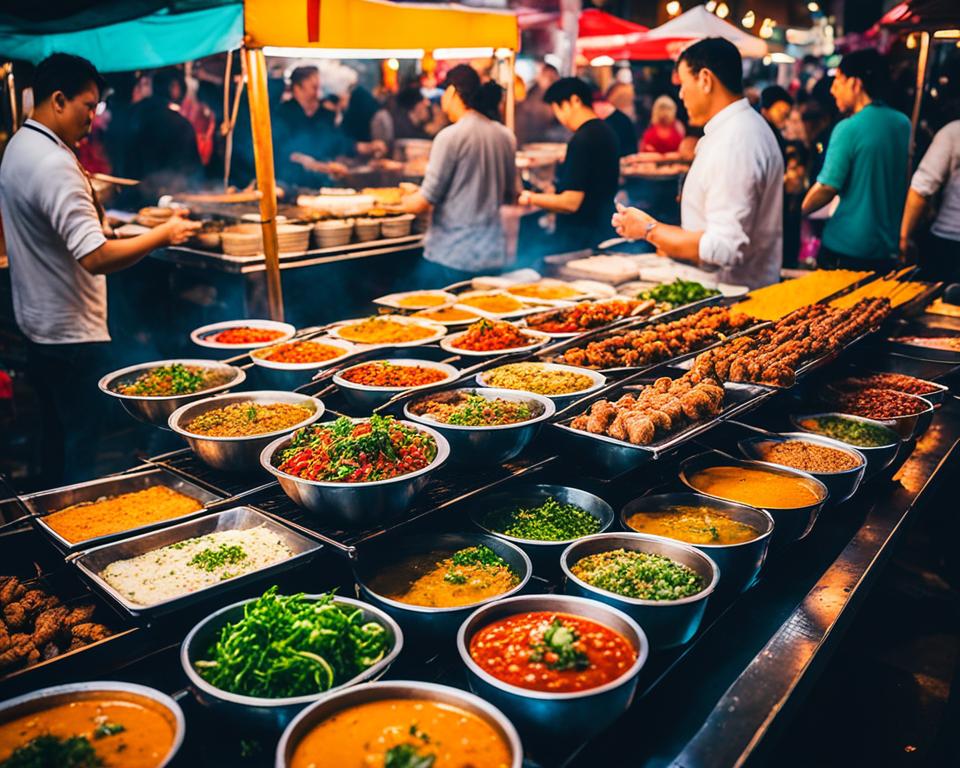
Navigating the maze of street food options can be an overwhelming experience, but it is also a quintessential part of the Thai culinary experience. From the sizzling grills of moo ping, the fragrant curries, and the refreshing som tam, the street food scene in Bangkok showcases the country’s unwavering passion for bold flavors and the celebration of culinary traditions.
Regional Thai Cuisine Specialties
While the dishes discussed so far are often considered representative of Thai cuisine as a whole, it’s important to recognize the diverse regional culinary traditions that exist within the country. From the rich, earthy flavors of Northern Thai (Lanna) cuisine to the bold, spicy dishes of the Southern regions, each area of Thailand has developed its own distinct culinary identity, influenced by local ingredients, cultural traditions, and historical trade routes. Exploring these regional specialties provides a deeper understanding of the depth and complexity of Thai cuisine.
Northern Thai Cuisine: Exploring Lanna Flavors
The northern region of Thailand, known as Lanna, is renowned for its distinct culinary traditions that have been shaped by the region’s geography, cultural heritage, and historical influences. Northern Thai cuisine is characterized by the use of hearty, earthy ingredients such as sticky rice, fermented sauces, and a variety of fresh herbs and vegetables. Iconic dishes from this region include the aromatic khao soi (a curry noodle soup), the savory larb (a minced meat salad), and the fragrant hang lay (a pork curry).
Southern Thai Cuisine: Coastal Influences and Spicy Dishes
In contrast, the southern regions of Thailand are known for their vibrant, spicy, and seafood-centric cuisine. Influenced by the abundance of fresh seafood from the nearby Andaman Sea and the Malay Peninsula, southern Thai dishes often feature bold, fiery flavors and a liberal use of chili peppers. Signature dishes from this region include the tangy and spicy tom yam goong (hot and sour shrimp soup), the pungent khao mok gai (turmeric rice with chicken), and the aromatic massaman curry.
Cooking Thai Food at Home
As the popularity of Thai cuisine continues to grow worldwide, many home cooks are eager to recreate the vibrant flavors of their favorite Thai dishes in their own kitchens. To do so, it’s essential to have a good understanding of the key ingredients and techniques that define Thai cooking.
Essential Thai Ingredients and Pantry Staples
From fish sauce and palm sugar to lemongrass and kaffir lime leaves, stocking the right pantry staples is crucial for achieving authentic Thai flavors. These essential ingredients form the foundation of many traditional Thai dishes, providing the perfect balance of sweet, sour, salty, and spicy elements that are characteristic of the country’s cuisine.
Tips for Balancing Thai Flavors
Additionally, mastering the balance of sweet, sour, salty, and spicy elements is a hallmark of Thai cuisine that home cooks can strive to emulate. By carefully combining and adjusting the proportions of these key flavors, you can create iconic Thai recipes that capture the essence of the country’s culinary traditions.
Vegetarian and Vegan Thai Dishes
While Thai cuisine is often associated with meat-based dishes, the country’s culinary traditions also offer a rich array of vegetarian and vegan options that celebrate the abundance of fresh, local produce. From the fragrant tom kha (coconut milk soup) to the vibrant som tam (green papaya salad), Thai chefs have demonstrated their creativity in crafting plant-based versions of iconic Thai dishes.
Plant-Based Thai Recipes
By focusing on the interplay of flavors and textures, these vegetarian and vegan Thai recipes showcase the versatility and adaptability of the country’s culinary heritage. Whether it’s a hearty massaman curry made with roasted vegetables or a refreshing pad thai featuring tofu and fresh herbs, traditional Thai dishes can be reimagined to cater to a wide range of dietary preferences while preserving the authentic flavors and aromas that have made Thai cuisine so beloved worldwide.
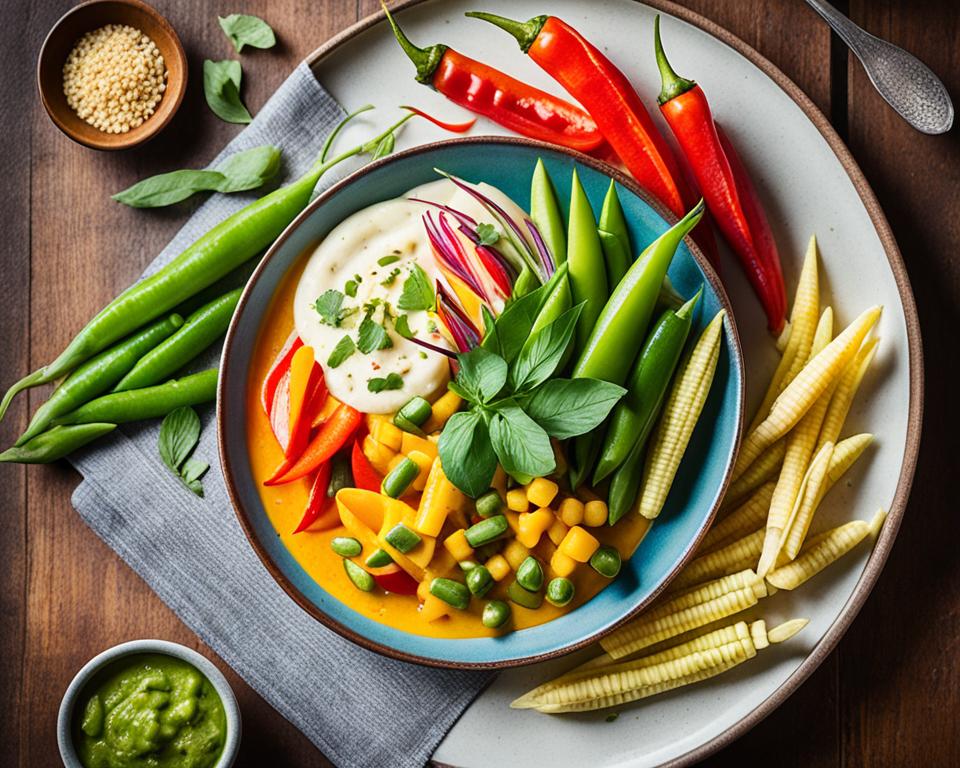
From the iconic moo ping (grilled pork skewers) to the comforting khao niaow ma muang (mango sticky rice), the traditional Thai dishes that have become iconic Thai recipes can be adapted to suit vegetarian and vegan diners, showcasing the versatility and inclusivity of Thai cuisine. By exploring these plant-based interpretations, home cooks and food enthusiasts can expand their culinary horizons and discover the vast potential of what is the national dish of thailand.
The Health Benefits of Thai Cuisine
In addition to its renowned flavors, Thai cuisine is also highly regarded for its health benefits. The abundance of fresh, locally-sourced ingredients, such as herbs, spices, and fresh produce, contribute to the nutritional value of Thai dishes. These ingredients are not only flavorful, but they also possess a wide array of vitamins, minerals, and antioxidants that can provide numerous health advantages.
Nutritional Value of Thai Ingredients
The cornerstone of Thai cuisine, ingredients like lemongrass, galangal, kaffir lime, and fresh chilies, are not only integral to the distinct flavors of Thai dishes but also offer a wealth of health benefits. These aromatic herbs and spices are packed with essential nutrients, such as vitamins, minerals, and phytochemicals, that can support overall well-being and reduce the risk of chronic diseases.
Thai Cooking Techniques and Their Health Advantages
The cooking methods commonly used in Thai cuisine, such as stir-frying, steaming, and the liberal use of aromatic herbs and spices, also contribute to the health benefits of Thai dishes. These techniques help to preserve the integrity and nutritional content of the ingredients, ensuring that the final dish retains its essential nutrients and phytonutrients. By incorporating the principles of balance and moderation, Thai cuisine offers a healthful and sustainable approach to dining that has gained recognition and admiration worldwide.
